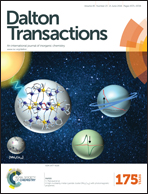Novel polyazamacrocyclic receptor decorated core–shell superparamagnetic microspheres for selective binding and magnetic enrichment of palladium: synthesis, adsorptive behavior and coordination mechanism†
Abstract
The development of economical and green technologies for the effective recovery of palladium has attracted worldwide attention in recent years. Magnetic separation involving the use of functional magnetic nanoparticles (MNPs) with superparamagnetic characteristics holds great promise in this respect. This study presents a novel class of core–shell structured superparamagnetic microspheres decorated with polyazamacrocyclic receptors, which show a highly-selective binding to Pd(II) in HNO3 media. The superparamagnetic microspheres possess a high saturation magnetization (53.8 emu g−1) and high adsorption capacity (qmax ≈ 105.3 μmol g−1), affording efficient enrichment and fast separation (within 13 seconds) of palladium under an applied magnetic field. Adsorptive behavior was fully investigated combined with the corresponding theoretical analysis by using kinetic equations and Langmuir/Freundlich isotherm models. Moreover, the coordination mechanism of the polyazamacrocyclic receptors to Pd(II) was carefully examined based on high resolution X-ray photoelectron spectroscopy (XPS) and FT-IR spectrophotometry. A suggested mechanism involving the synergistic effect of the cyclic amines and carboxyl arms of the polyazamacrocyclic receptors was proposed to describe the coordination manner, while explaining the selectivity to Pd(II) in HNO3 solutions. From a practical perspective, the Pd(II)-enriched microspheres could be readily regenerated for cycle use. We conclude that this kind of polyazamacrocyclic receptor decorated superparamagnetic microsphere is of potential use for the effective recovery of Pd(II) as well as other precious metals.


 Please wait while we load your content...
Please wait while we load your content...